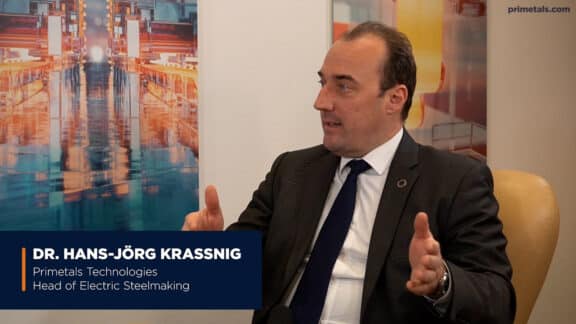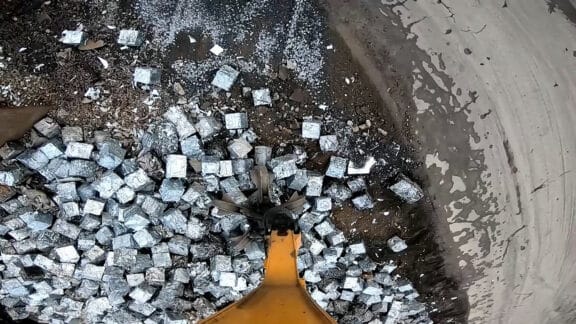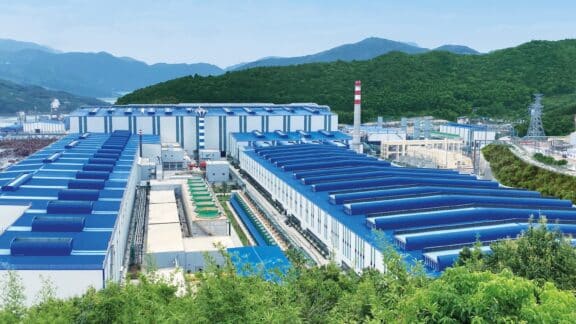With a long history of use in the steel industry, the electric arc furnace is emerging as a significant and essential player in the steel industry’s future. With all eyes on green steel production, an electric arc furnace powered by renewable energy offers the optimal route for carbon emissions reduction. The advantages of an EAF are numerous, and EAFs today boast capacities and steel-grade production capabilities that parallel the BOF. With its diverse portfolio, Primetals Technologies is helping define the future of electric steelmaking.
Steel producers worldwide are pursuing a means to decarbonize, maintain, and advance their plants. While the integrated blast furnace–basic oxygen furnace route remains dominant, diverse producers and future-oriented industry leaders recognize the need for new steel production. Albeit a technology with its foundation in a long history of steelmaking since the early 1900s, the electric arc furnace has come a long way in the past century, and today’s furnaces would seem impossible from the earliest ratings of 500 kilowatts and 4-ton capacities. At Primetals Technologies, the electric arc furnace is a critical player in the future of steelmaking.
The emergence of electric steelmaking
Before delving into what makes electric steelmaking a vital part of the steel industry’s future, understanding the history of the electric arc furnace and its functions is worth a brief explanation. While the first successful experiments of an electric arc date back to 1808, it was in 1900 that the first commercial application of the direct arc steelmaking furnace took place. The first furnaces were adopted in North America, in both the U.S.A. and Canada. In just 20 years, the capacities of electric arc furnaces went from 4 tons to 15-20 tons using automatic regulators and, decades later, replacing carbon electrodes with graphite.
Electric arc furnaces saw greater adoption after World War II. Thanks to their construction and ability to integrate into minimills, steel produced via an electric arc furnace makes up nearly one-third of global steel production today. Reports anticipating the future of the steel industry and a rise in green steel production suggest that China’s electric steel production will rise to 20 percent of steel production by 2030. Such a rapid increase in electric steelmaking aligns with increased scrap consumption to aid in the decarbonization of the steel industry.
Scrap preheating
Alongside an increase in electric steelmaking in the future, scrap melting in an electric arc furnace provides steel producers with a primary means of reducing their carbon emissions efficiently and effectively. Yet, beyond the benefit of carbon emissions reduction, electric arc furnaces also offer efficient tap-to-tap times increasing productivity. The EAF Quantum by Primetals Technologies provides producers with a swift tap-to-tap time of just 33 minutes. However, this is just one benefit of the EAF Quantum.
With scrap preheating and the Furnace Advanced Slag-free Tapping system, the EAF Quantum offers efficient and lightning fast tap-to-tap times and increased capacities.
Recognizing the relevance of scrap melting for electric steelmaking, specialists at Primetals Technologies developed the EAF Quantum with an innovative scrap preheating method. A shaft captures the off-gas from furnace operations and redirects it to a section containing scrap prepared to be charged to the hot metal bath of the EAF. Equipped with an elevator that lifts the scrap chute, transportation logistics also benefits from EAF Quantum’s operation. By preheating the scrap, energy savings are also a factor as the workload of the electrodes is spared the necessity of heating room temperature scrap. Considering the additional Furnace Advanced Slag-free Tapping (FAST) system, the EAF Quantum has lightning-fast tap-to-tap times, increasing overall production capacities.

Digital, Automated, Reliable
While an electric arc furnace presents clear benefits in cost, return on investment, production capacities, and environmentally friendly steel production, one clear additional advantage is how EAFs integrate seamlessly with practical digital and automation tools. One clear example is the Melt Expert from Primetals Technologies. Able to control both the EAF and ladle furnaces, the Melt Expert allows for the accurate reproduction of a specific melting process by controlling the electrodes based on production data.

Interview with
Dr. Hans-Jörg Krassnig
Head of Electric Steelmaking at Primetals Technologies, Dr. Hans-Jörg Krassnig, is focused on expanding and revolutionizing electric steelmaking at Primetals Technologies.
What role will electric steelmaking play in the coming decades?
Dr. Hans-Jörg Krassnig: A major role. The trend to substitute integrated steel plants with EAF-based meltshops will expand with increased requirements to decarbonize the industry. With EAF-based steelmaking, the CO2 reduction potential is more than 90 percent using crafted scrap, hydrogen-based DRI, renewable powered EAFs, and increased deployment of CCUS.
What sets electric steelmaking at Primetals Technologies apart?
Krassnig: It is the people, the specialists at Primetals Technologies, that sets us apart. Specialists who bring comprehensive expertise in ancillary systems, environmental technology, logistics, assembly, project management, and automation and digitalization.
What is on the horizon for electric steelmaking? Where are we headed?
Krassnig: High-quality steel-grade production using EAFs will be key in the near future. Knowledge about raw materials and scrap, and digitalization of all process steps will support improvements in product quality, by making the electric steelmaking process more transparent. Our task is to deliver groundbreaking solutions to redefine high-quality EAF-based steel production.
Operators can inspect the melting process using a clear and accessible interface using historical and real-time data. The algorithms informing Melt Expert will also adapt based on energy requirements and dynamically adjust the process. In summary, Melt Expert controls the melting process and works ideally with the power solution Active Power Feeder, which provides precision control of the arc itself while also keeping a clean grid. Producers can thus reduce energy consumption and increase productivity and reliability by using these solutions in tandem with their electric arc furnaces.

Salzgitter has joined forces with industry partners and researchers to lay the foundations for a “virtually CO2-free steel production.” Focusing their attention on carbon direct avoidance, the crucial elements of the project involve electricity from renewable sources and the production of hydrogen using electrolysis to create green hydrogen. Using hydrogen as an iron-reducing agent is key to their goals, as well as increasing the utilization of scrap and completing refinement in an electric arc furnace.
The Future is Electric
While this is only a brief overview, what’s clear: the future is electric. The industry is trending toward electric steelmaking, and developments at Primetals Technologies are here to facilitate this transition. Already the trend toward electric steelmaking is taking hold around the world. For example, in Germany, steel producer Salzgitter has committed to its transformation toward electric steelmaking, investing in an EAF Ultimate with a tapping weight of 220 tons combined with the world’s largest waste heat recovery system. As part of their low-carbon initiative—i.e., the Salzgitter Low CO2 Steelmaking (SALCOS) project—their entire production will transform by 2033.
The project will total three electric arc furnaces, and two direct reduction plants will completely replace Salzgitter’s existing blast furnaces and converters. However, this is just one example of the types of transitions on the horizon. Other producers are also looking at transforming their production processes, and electric steelmaking plays a central role. Whether parallel operations alongside converters or a complete transformation, the revolution of electric steelmaking has genuinely begun and will define the steel industry’s future.
Electricity has always been a fascinating marvel of modern technology. Since the legendary observation of lightning by Benjamin Franklin, electricity has done nothing short of inspiring technologists and scientists for generations. And while it is indeed a powerful force, controlling it would be the equivalent of “catching lightning in a bottle,” and Primetals Technologies has done just that.
CLEAN, STABLE ENERGY
The Active Power Feeder by Primetals Technologies is a means of controlling the uncontrollable, that is, the power from the grid to the electric arc furnace. The Active Power Feeder provides seamless control and targets specific arc lengths with impeccable precision. By regulating the incoming electrical power, the arc within the EAF can maintain consistent power levels regardless of the grid’s energy quality. Constant power levels in different process phases mean that heats and melting rates can all be controlled and maintained consistently. And the arc control is also integrated into the Melt Expert, providing immediate feedback and improving using historical and real-time data.
GRID CONTROL
While controlling the arc in the EAF is essential, proper power regulation on the operations side is equally important for reducing flicker and keeping the power grid clean. In particular regions, this is extremely important as it ensures minimal disturbances to the grid, which often incurs unanticipated costs for the steel producer. Moreover, flicker is a problem during operations because an influx or irregularities in the arc decreases efficiency. The Active Power Feeder is the ideal solution for electric steelmaking and is, in its design and implementation, unique to Primetals Technologies. The Active Power Feeder is the perfect solution for electric steelmaking, offering complete control and regulation of the arc and incoming and outgoing power.


